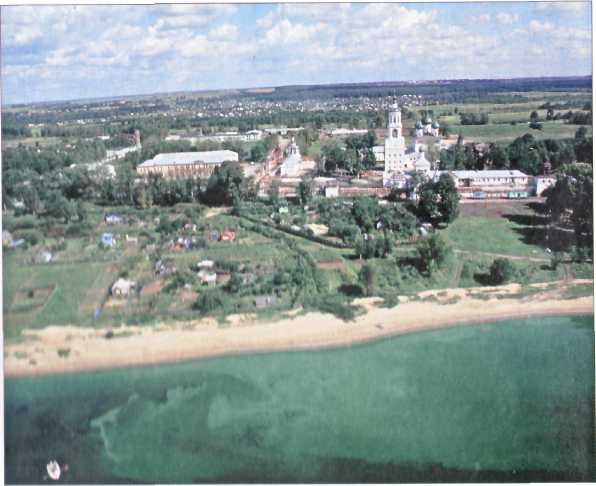
- •Architecture
- •11Th - 12th century. The growth of towns
- •13Th to 14th century. Mongol-tartar overlordship
- •15Th -16th century. The moscow architectural school
- •Monastery building
- •17Th century. The golden age of mediaeval russia
- •18Th – 19th century. New town-planning ideas
- •19Th to early 20th century. Historism. Art nouveau. Avant garde
- •The mediaeval Russian church
- •Mediaeval russian icon- and fresco-painting
- •The interior of a russian church.
- •Iconostasis.
- •The technique of icon-painting
- •Fresco-painting
- •Mediaeval russian sculpture
13Th to 14th century. Mongol-tartar overlordship
In the early decades of the 13th century the Vladimir lands became divided up into many small principalities, each of which strove to make its capital as impressive as possible. In many towns the stone cathedrals were rebuilt or enlarged. In 1222-1225 the Cathedral of the Nativity of the Virgin was erected in Suzdal, which is still standing today. The Tartar invasions of the mid-13th century changed the whole course of Russian history. Much of what had been achieved in the preceding centuries was destroyed by fire and sword, including the architecture, of course. There was no new building for a very long time, almost a whole century. The capital moved from Vladimir to Moscow. After managing to unite North-east Russia around their lands, the princes of Moscow were able to determine "architectural policy" as well. The influence of the Moscow school began to be felt in all the towns on the Golden Ring. The old models were not forgotten, however, but were creatively reworked and used in the building of the next few centuries. An example of this is the Trinity Cathedral in the Trinity Monastery of St Sergius.
15Th -16th century. The moscow architectural school
The Moscow architectural school as a universal one for the whole of the united Russian state emerged at the end of the 15th century and first half of the 16th. From then onwards the main models for church building all over Russia were the cathedrals in the Moscow Kremlin: the Assumption Cathedral where the grand princes and tsars were crowned and the Archangel Cathedral, the burial place of the rulers of Russia. These large, rectangular cathedrals with six monumental pillars inside and five domes on top influenced the building of the Assumption Cathedral in the Trinity Monastery of St Sergius and the St Nicetas Cathedral in Pereslavl-Zalessky.
Tolga Convent, Yaroslavl, 17th-19th century |
In the early 16th century a type of tall church with a kind of thick spire topped by a small dome appeared the so-called tent-roofed church. The first one was the Church of the Ascension in Kolomenskoye, then on the outskirts of Moscow. Throughout the 16th, and particularly in the 17th century, tent-roofed churches went up in all the towns of the Golden Ring. Most noteworthy are those of St Peter the Metropolitan in Pereslavl-Zalessky and SS Cosmas and Damian in Murom, and also numerous tent-roofed bell-towers, such as those of the Cathedral of the Nativity of the Virgin and the Intercession Convent in Suzdal, the St Michael the Archangel Monastery in Yunev-Polsky, and the churches of Elijah the Prophet and St John Chrysostum in Yaroslavl. |
Monastery building
The development of monastery building was of tremendous importance for mediaeval Russian architecture. In the 16th and 17th century the monasteries played a vital role in the culture of Northeast Russia. They were major religious centres where art and literature flourished. As the owners of extensive lands donated to them by the grand princes, tsars and nobility, the monasteries were able to erect large buildings and many monasteries turned into magnificent architectural ensembles. At the same time, surrounded by powerful walls and towers, they served as strategic fortresses of the Moscow state.
Monasteries appeared in Russia shortly after the adoption of Christianity in 988, but the real flowering of monastic culture began in the 14th century. It is connected with the name of St Sergius of Radonesh, the founder of Russia's most famous monastery, the Trinity Monastery of St Sergius that lies within the Golden Ring. Each monastery had its main cathedral and a church adjoining the refectory where the monks ate together. Around these buildings usually in a ring were the cells, infirmary, almshouses where cripples and pilgrims could stay and domestic buildings, such as the bakery and various workshops and storehouses.
The monastery was surrounded by walls and towers, and there was a gateway church over the main entrance. This scheme was used no matter where the monastery was built, in town or country. Each town in the Golden Ring area usually had several monasteries in and around it. This gave the town a special structure consisting of a spacious secular part with only a few buildings and the monastic section encircled by walls that enclosed a densely built-up area in Suzdal, for example, the whole fabric of the town is made up of monastery or convent ensembles. Facing each other across the river are the Intercession Convent and the Spaso-Yevfimievsky Monastery. Equally rich in monasteries are Rostov, Pereslavl-Zalessky, Uglich, Yaroslavl and Kostroma The latter has the famous Hypatian Monastery.

